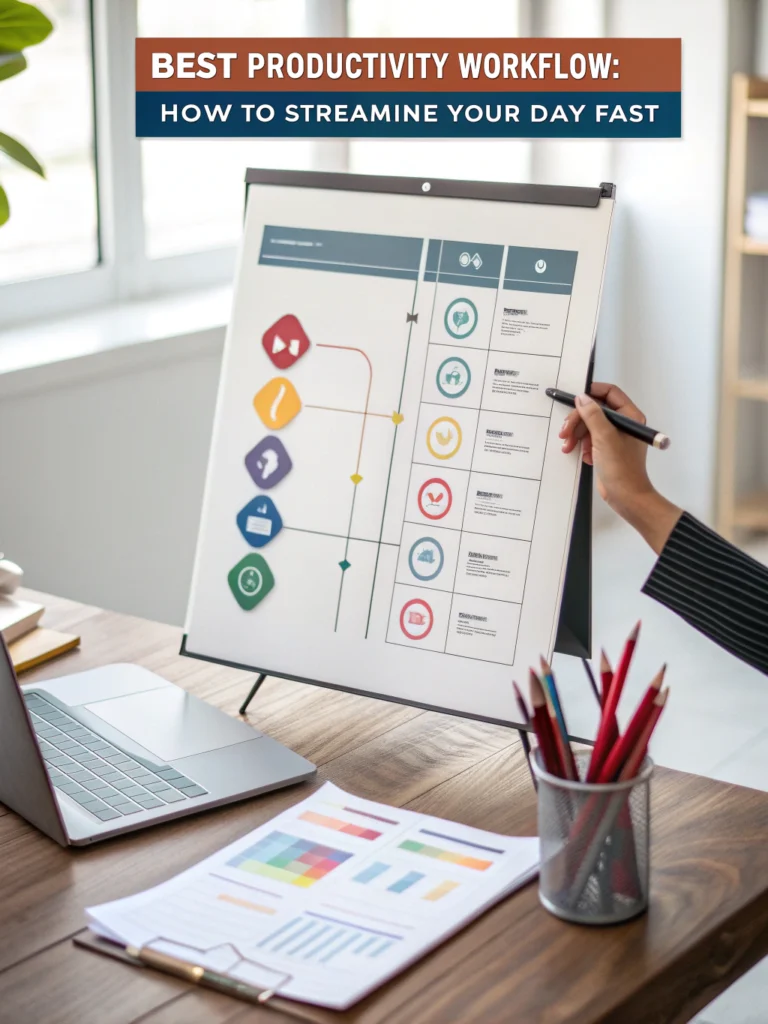Best Productivity Workflow: How to Streamline Your Day Fast
Looking for the best productivity workflow to transform your chaotic days into streamlined success? I've been there – drowning in tasks while watching my precious hours vanish. After testing dozens of methods and systems, I've cracked the code on what actually works in the real world.
Why Most Productivity Systems Fail You
Most productivity advice feels great for about three days before reality hits. The fancy apps collect digital dust, and those complex systems you tried to implement? They're now part of the problem.
The truth is simple: the best productivity workflow isn't about doing more—it's about doing what matters in a way that works with your brain, not against it.
The Core Elements of an Effective Productivity Workflow
Before diving into the specific steps, let's understand what makes a workflow stick:
- Simplicity – If it's too complex, you'll abandon it when stressed
- Flexibility – It should bend without breaking on chaotic days
- Visibility – You need to see what matters at a glance
- Completion focus – Built to help you finish, not just plan
Morning Launch: Set Up Your Day For Success
The first 30-60 minutes of your day will make or break your productivity. Here's how to nail it:
- Avoid digital input for the first 15 minutes (no phone, no email)
- Write down 1-3 must-complete tasks before anything else
- Block your calendar for those priority tasks before the day's distractions hit
This approach is part of what I call the "priorities-first workflow" that has revolutionized how I approach my mornings. For more morning optimization ideas, check out these productivity desktop background ideas that can reinforce your workflow every time you sit down at your computer.

Task Management: The RIGHT Way to Process Work
The way you organize tasks determines whether they'll get done. Most people make these critical mistakes:
- Keeping tasks in multiple places (digital and paper)
- Not distinguishing between big projects and simple tasks
- Missing deadlines because tasks aren't tied to specific times
Instead, implement these time management strategies:
- Use ONE central task system (digital or paper – consistency matters more than the tool)
- Break down any task that takes more than 30 minutes into smaller steps
- Assign specific time blocks for each important task in your calendar
Looking to take your task management to the next level? The >AI for Productivity eBook + Checklist: Supercharge Your Efficiency in 2141 provides cutting-edge AI-powered approaches to task management that most people aren't yet using.
Energy Management Trumps Time Management
One of the most powerful ways to boost work efficiency is to match tasks to your energy levels. Map your day like this:
- High energy hours: Creative work, difficult decisions, complex problem-solving
- Medium energy: Meetings, collaborative work, routine tasks requiring focus
- Low energy: Administrative tasks, email, low-stakes decisions
For a deeper dive into this concept, explore energy management for productivity tips that can help you maximize your natural rhythms.
Communication Batching: Stop the Interruption Cycle
Nothing kills productivity faster than constant interruptions. To streamline your workflow, implement these communication protocols:
- Check email and messages at specific times (I recommend 11am, 2pm, 4pm)
- Use status messages on Slack/Teams to create focused work periods
- Set up autoresponders during deep work blocks
Decision Minimization: Eliminating Decision Fatigue
Each decision you make drains your mental energy. Create best daily routine hacks by automating these decisions:
- Pre-plan outfits for the week
- Create meal templates or subscription services
- Develop standard operating procedures for recurring tasks
- Use templates for common emails/messages
For more ways to reduce decision fatigue, explore these desk productivity tools to organize workspace that can create physical environments that reinforce your workflow.
Digital Tools That Actually Help (Not Hurt) Productivity
The right productivity tools for professionals can be game-changing, but only when selected carefully. Here's what I recommend:
- Task management: Todoist or ClickUp (digital) or BulletJournal (analog)
- Time blocking: Google Calendar or Microsoft Outlook
- Focus sessions: Forest App or Pomodoro timers
- Note-taking: Notion or Obsidian for connected notes
For those with focus challenges, the >ADHD Productivity Power Pack: Ebooks, Guides, Checklists, Workbook & Tools to Master Focus, Time Management & Organization provides specialized strategies that work with diverse attention styles.
Weekly Review: The Missing Link in Most Workflows
The most overlooked component of an effective productivity system is the weekly review. To optimize your schedule:
- Block 30 minutes every Friday or Sunday
- Review what worked/didn't work this week
- Clear all inboxes to zero
- Schedule all critical tasks for the coming week
- Align your calendar with your priorities
I've found that the productivity method planner guide offers excellent templates for conducting effective weekly reviews that keep your workflow on track.
Creating Your Personal Productivity Workflow
The best system is the one you'll actually use. Here's how to build yours:
- Start with just ONE technique from this article
- Practice it daily for two weeks
- Add another layer only after the first becomes automatic
- Track what works and what doesn't
- Ruthlessly eliminate anything that feels like a chore
Remember, productivity isn't about doing more—it's about achieving what matters most with minimal friction. The best productivity workflow evolves with you, becoming more refined as you learn what truly helps you thrive.
FAQs About Creating the Best Productivity Workflow
How long does it take to establish a new productivity workflow?
Most people need 21-30 days to fully integrate a new productivity system. Start with core elements and add complexity gradually rather than overhauling everything at once.
Should I use digital or analog tools for my productivity system?
This depends entirely on your work style and preferences. Digital systems offer automation and synchronization, while analog systems provide tactile feedback and fewer distractions. Many successful professionals use a hybrid approach.
How do I stick with my productivity workflow during busy or stressful times?
This is precisely when your system should simplify, not expand. During high-stress periods, focus only on your MIT (Most Important Task) system and energy management, letting go of the more complex elements until things calm down.
Can the same productivity workflow work for different types of jobs?
The principles remain constant, but implementation varies. Knowledge workers benefit from deep work blocks and distraction management, while service professionals need systems for quick context-switching and appointment management.
What's the biggest mistake people make when creating a productivity workflow?
Overcomplicating the system is the number one killer of productivity workflows. If your system requires more than 10 minutes of maintenance daily, it's too complex and will collapse under pressure.
The best productivity workflow is one that feels like it's working for you, not the other way around. Start small, build gradually, and soon you'll find yourself accomplishing more with less stress and greater satisfaction.

